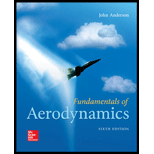
(The purpose of this problem is to calculate a two-dimensional expanding supersonic flow and compare it with the analogous quasi-one-dimensional flow in Problem 10.15.) Consider a two-dimensional duct with a straight horizontal lower wall, and a straight upper wall inclined upward through the angle
Want to see the full answer?
Check out a sample textbook solution
Chapter 9 Solutions
Fundamentals of Aerodynamics
Additional Engineering Textbook Solutions
Thermodynamics: An Engineering Approach
HEAT+MASS TRANSFER:FUND.+APPL.
Mechanics of Materials, 7th Edition
Applied Statics and Strength of Materials (6th Edition)
EBK FUNDAMENTALS OF THERMODYNAMICS, ENH
Thermodynamics: An Engineering Approach
- A 20◦ half-angle wedge is mounted at 0◦ angle of attack in the testsection of a supersonic wind tunnel. When the tunnel is operating, thewave angle from the wedge leading edge is measured to be 41.8◦. Whatis the exit-to-throat area ratio of the tunnel nozzle?arrow_forwardAir flows through a constant cross-section conduit with Mack number Ma = 1 at 200 KPa pressure and 100°C temperature. State the necessary assumptions and calculate, (a) stagnation temperature (b) stagnation pressure, and (c) stagnation density.(d) With the specified inlet velocity a gas is flowing isentropically in the converging duct. At thethroat if we assume that the velocity is supersonic, how does the mass flow rate be affectedcompared to sonic velocity at the throat. How could supersonic velocity can be achieved in thiscase?arrow_forwardConsider a wing mounted in the test-section of a subsonic wind tunnel. The velocity of the airflow is 160 ft/s. If the velocity at a point on the wing is 195 ft/s, what is the pressure coefficient at this point?arrow_forward
- Consider a low-speed subsonic wind tunnel designed with a reservoir cross-sectional area of 2 m2 and a test-section cross-sectional area of 0.5 m2. The pressure in the test section is 1 atm. Assume constant density equal to standard sea level density, calculate the pressure (in Pa) required in the reservoir necessary to achieve a flow velocity of 40 m/s in the test section.arrow_forwardAir enters a converging–diverging nozzle of a supersonic wind tunnel at 150 psia and 100°F with a low velocity. The flow area of the test section is equal to the exit area of the nozzle, which is 5 ft2. Calculate the pressure, temperature, velocity, and mass flow rate in the test section for a Mach number Ma = 2. Explain why the air must be very dry for this application.arrow_forwardA supersonic flow passes over a symmetrical wedge of semi-angle α = 10° . At the leading edge an attached shock of β = 30° is observed. Find: (a) The upstream Mach number. (b) The downstream Mach number. (c) The static pressure ratio across the shock.arrow_forward
- Consider a flat plate at an angle of attack in an inviscid supersonic flow.From linear theory, what is the value of the maximum lift-to-drag ratio,and at what angle of attack does it occur?arrow_forwardConsider a supersonic flow with M = 2, p = 1 atm, and T = 288 K. This flow isdeflected at a compression corner through 20◦. Calculate M, p, T , p0, and T0 behind the resulting oblique shock wave.arrow_forward1. Consider a low-speed subsonic wind tunnel designed with a reservoir cross-sectional area A, = 2 m2 and a test-section cross-sectional area A2 = 0.5 m2. The pressure in the test section is P2 = 1 atm. Assume constant density equal to standard sea level density, calculate the pressure (in kPa) required in the reservoir, P1, necessary to achieve a flow velocity V2: 40 m/s in the test section. a. From item no. 1, calculate the mass flow rate (in kg/s) through the wind tunnel. b. Calculate the Mach number of the vehicle in air. c. Calculate the Mach number of the vehicle in hydrogen.arrow_forward
- An aircraft is flying at supersonic speed. At a component of an aircraft where the flow is perpendicular, the density ratio is 5. Solve for: a.Mach Number Downstream b. Pressure Ratio c. Temperature Ratio d. Mach Number upstreamarrow_forwardA tiny scratch in the side of a supersonic wind tunnelcreates a very weak wave of angle 17°, as shown in Fig., after which a normal shock occurs. The air temperaturein region (1) is 250 K. Estimate the temperaturein region (2).arrow_forwardConsider an oblique shock wave with a wave angle of 30◦ in a Mach 4flow. The upstream pressure and temperature are 2.65 × 104 N/m2 and223.3 K, respectively (corresponding to a standard altitude of 10,000 m).Calculate the pressure, temperature, Mach number, total pressure, and totaltemperature behind the wave and the entropy increase across the wave.arrow_forward
 Elements Of ElectromagneticsMechanical EngineeringISBN:9780190698614Author:Sadiku, Matthew N. O.Publisher:Oxford University Press
Elements Of ElectromagneticsMechanical EngineeringISBN:9780190698614Author:Sadiku, Matthew N. O.Publisher:Oxford University Press Mechanics of Materials (10th Edition)Mechanical EngineeringISBN:9780134319650Author:Russell C. HibbelerPublisher:PEARSON
Mechanics of Materials (10th Edition)Mechanical EngineeringISBN:9780134319650Author:Russell C. HibbelerPublisher:PEARSON Thermodynamics: An Engineering ApproachMechanical EngineeringISBN:9781259822674Author:Yunus A. Cengel Dr., Michael A. BolesPublisher:McGraw-Hill Education
Thermodynamics: An Engineering ApproachMechanical EngineeringISBN:9781259822674Author:Yunus A. Cengel Dr., Michael A. BolesPublisher:McGraw-Hill Education Control Systems EngineeringMechanical EngineeringISBN:9781118170519Author:Norman S. NisePublisher:WILEY
Control Systems EngineeringMechanical EngineeringISBN:9781118170519Author:Norman S. NisePublisher:WILEY Mechanics of Materials (MindTap Course List)Mechanical EngineeringISBN:9781337093347Author:Barry J. Goodno, James M. GerePublisher:Cengage Learning
Mechanics of Materials (MindTap Course List)Mechanical EngineeringISBN:9781337093347Author:Barry J. Goodno, James M. GerePublisher:Cengage Learning Engineering Mechanics: StaticsMechanical EngineeringISBN:9781118807330Author:James L. Meriam, L. G. Kraige, J. N. BoltonPublisher:WILEY
Engineering Mechanics: StaticsMechanical EngineeringISBN:9781118807330Author:James L. Meriam, L. G. Kraige, J. N. BoltonPublisher:WILEY





